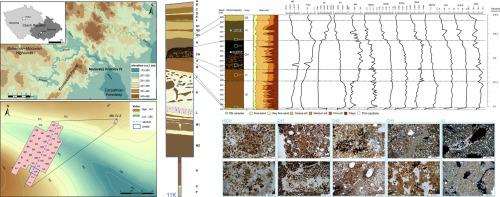Catena ( IF 5.4 ) Pub Date : 2021-01-26 , DOI: 10.1016/j.catena.2021.105174 Katarína Adameková , Lenka Lisá , Petr Neruda , Jan Petřík , Nela Doláková , Jan Novák , Jiří Volánek

|
Only a few loess–palaeosol sequences from the last climatic cycle (Eemian-Weichselian) in East-Central Europe have been studied and correlated with up-to-date stratigraphic frameworks such as marine isotope stages (MIS) and Greenland Stadials/Interstadials (GS/GI). This paper examines the relations of local conditions and climatic trends to soil development, and the character of vegetation during MIS 5 period at the Palaeolithic site Moravský Krumlov IV. To revise the chronostratigraphy and interpretation of palaeosols, we applied a multi-proxy approach based on soil micromorphology, physical and geochemical analyses together with palaeobotanical evidence and results of optically stimulated luminescence dating. The part of the loess–palaeosol sequence under study was correlated with the Dolní Věstonice sequence and represents a time span from MIS 5e to MIS 5b. It comprises an Eemian luvisol (MIS 5e, Interglacial), an Early Weichselian chernozem (MIS 5e, GI 25) and a colluvium with a pedogenic imprint (MIS 5d, GI 24), loess (MIS 5d, GS 24), regosol (MIS 5c/5d, GI 23), and loess deposits (MIS 5c, GS 23). Unlike for the Dolní Věstonice, the record of MIS 5a has not been proved and there are no markers dividing individual palaeosols. The intensity of weathering is similar to comparable records from the Czech Republic and is elevated compared to Hungarian loess–palaeosol sequences. Evidence of forest vegetation with both deciduous and coniferous trees (MIS 5e, Interglacial) is followed by that of a steppe environment with a mosaic of trees (MIS 5e, GI 25) and, finally, a tundra or forest-tundra vegetation (MIS 5d, GI 24). Eemian luvisol is rarely preserved but recorded in contemporary sequences from the Czech Republic. The Early Weichselian part is rather similar to the record documented across sites in Lower Austria, in contrast to sites from the Czech Republic, and does not fit into the earlier established system of pedocomplexes.
中文翻译:

MIS 5的病历记录,作为气候趋势和当地条件的相互作用:MoravskýKrumlov IV(捷克共和国摩拉维亚)旧石器时代遗址的多代理证据
仅研究了东欧中部最后一个气候周期(Eemian-Weichselian)中的一些黄土-古土壤序列,并将其与最新的地层学框架(例如海洋同位素阶段(MIS)和格陵兰陆生/陆际(GS))相关联/ GI)。本文研究了旧石器时代遗址MoravskýKrumlov IV的MIS 5时期当地条件和气候趋势与土壤发育的关系以及植被的特征。为了修订年代地层学和古土壤的解释,我们基于土壤微观形态,物理和地球化学分析以及古植物学证据和光学激发发光测年的结果,应用了多代理方法。研究中的黄土古土壤序列的一部分与DolníVěstonice序列相关,代表了从MIS 5e到MIS 5b的时间跨度。它由Eemian luvisol(MIS 5e,冰间期),Weichselian黑钙石早期(MIS 5e,GI 25)和带有成岩作用的胶结层(MIS 5d,GI 24),黄土(MIS 5d,GS 24),regosol(MIS) 5c / 5d,GI 23)和黄土沉积物(MIS 5c,GS 23)。与DolníVěstonice不同的是,MIS 5a的记录尚未得到证实,也没有划分各个古土壤的标记。风化强度类似于捷克共和国的可比记录,并且比匈牙利黄土古土壤序列高。有落叶和针叶树的森林植被证据(MIS 5e,冰川间),接着是有树木镶嵌的草原环境的证据(MIS 5e,GI 25),最后是苔原或森林苔原植被(MIS 5d,GI 24)。Eemian luvisol很少保存,但以捷克共和国的当代序列记录。与捷克共和国的站点相比,魏克塞勒时代的早期部分与下奥地利州各地记录的记录相当相似,并且不适合早期建立的脚踏复合体系统。









































 京公网安备 11010802027423号
京公网安备 11010802027423号